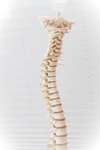Back pain and sports: what if swimming wasn't so good?

Since almost the dawn of time, we have been hearing that when your back hurts, you should take up swimming and stop running! At the risk of shocking many people, I am pleased to write this article based on the latest studies, in order to change mentalities and beliefs about back pain and swimming.
Please note that the purpose of this article is not to tell you to stop swimming but to do more than just swim!
Swimming is not the best sport for your back!
We mistakenly thought that swimming was ideal for our backs because there was no strain and therefore we would not get tired. In reality, it is the constraints that make our body react by strengthening itself. In swimming, we don't have the impact that stimulates the discs and strengthens them. In addition, when we swim, the swinging motion adds stress to the discs between the vertebrae.
Small anatomical reminder on the intervertebral discs:

In this picture, the entire spine is shown, composed of cervical, thoracic and lumbar vertebrae. Between the vertebrae, there are discs that act as small absorbent cushions.
When these discs are damaged, it is called disc disease (disc pathology). In some cases, they can herniate, which is called disc herniation.
The back of swimmers compared to other sports:

In 2009, Hangai observed the prevalence of disc degeneration in non-athletes and athletes according to sports. He observed the following data:
- In runners, 25.6% of discopathy is found
- In non-athletes: 31.4%.
- In soccer players: 36.2%.
- In basketball players: 42.9%.
- In swimmers: 57.5%.
- In baseball players: 59.7%.
For a long time we thought that these discs deteriorated due to shocks but the studies below as well as the one of 2014 made by the Australians with runners show the opposite: running strengthens the discs between the vertebrae!
Backstroke Comparison of Elite VS Casual Swimmers

In 2007, Kaneoka evaluated the condition of the intervertebral discs in elite and occasional swimmers using MRI scans. He concluded that:
- 68% of elite swimmers have disc disease,
- 29% in the occasional swimmers group.
But rest assured in 2016, Steffen Folkvardsen redid much the same study and drew the conclusion that there was no difference between the elite and the casual swimmer.
Why?
Because between 2007 and 2016, we changed the physical preparation of the swimmer! The elite swimmer spends a little less time in the pool but more time running, jumping and strengthening muscles.

The different types of swimming and discopathy:
I know, you say "yes but it depends on the type of swimming". Many of us thought that swimming was good for the back unless you were doing breaststroke and then there were the studies...
Also in 2007, Kaneoka showed the prevalence of disc disease in elite swimmers based on type of swimming and his findings are as follows:
- 83% of elite swimmers with disc disease are CRAWL!
- 67% of them do BRASS.
- 62% do DOS.
- 60% practice the PAPILLON.
Swimming and back deformities
Fabia Zaina compared back deformities in a group of 112 competitive swimming adolescents and a group of 217 non-swimming adolescents in 2015.
He highlighted that in the group of swimmers there was an increase in frontal and sagittal static disorders!
Swimming gear increases injuries!

Swimming equipment such as fins and pull-boys should be used only when physical condition permits.
- The pull boy: by increasing the lumbar lordosis, it will increase the constraints of the lumbar spine.
- The platelets: it is at the level of the shoulders that they are catastrophic when there is a deficit of the external rotator and fixator muscles of the scapula.
Conclusion
The purpose of this article is not to make you stop swimming, on the contrary, but to encourage you to supplement with other exercises such as strength training, running, etc.
Advice from your osteo
Your osteo will advise you on exercise programs including:
- A muscular warm-up and joint unlocking for 10-15 minutes at the beginning of the session
- Strengthening of muscles
- 2 to 3 weight training sessions per week (depending on level)
- 1 to 2 sessions of General Physical Preparation (GPP)
per week adapted to the swimmer
- Cold stretching after each session
- Healthy living
- Good nutrition
- Healthy teeth...
- Only use equipment (fins, fins, pullboys)
only if your physical condition allows it!
Marie Messager
Osteopath for sports
2 rue Alexis de Tocqueville
78000 Versailles
